KIA CARENS RHD 2018 Owners Manual
Manufacturer: KIA, Model Year: 2018, Model line: CARENS RHD, Model: KIA CARENS RHD 2018Pages: 723, PDF Size: 40.94 MB
Page 571 of 723
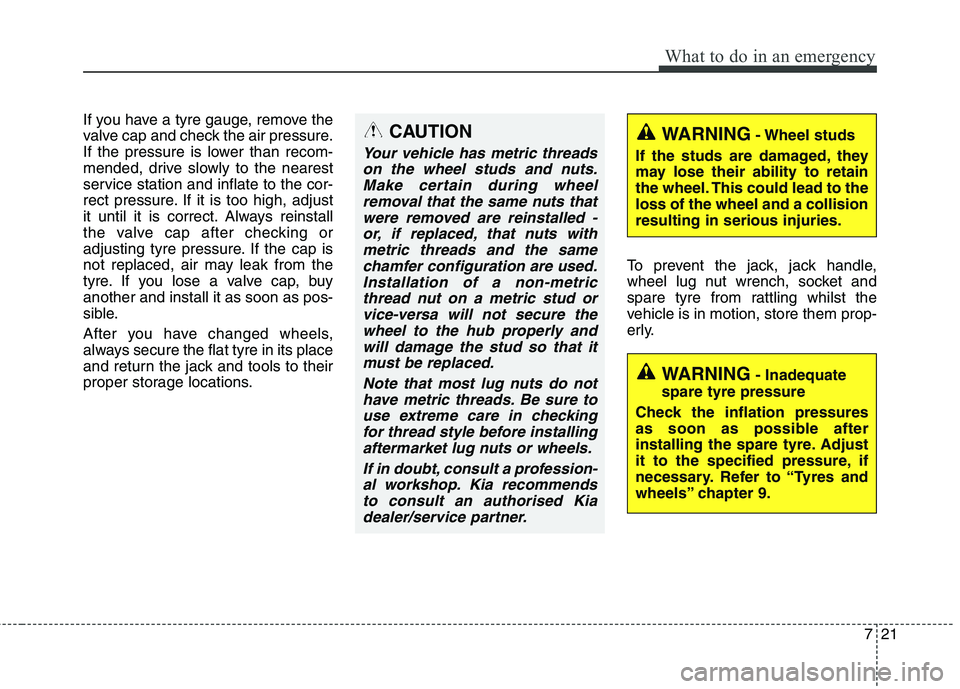
721
What to do in an emergency
If you have a tyre gauge, remove the
valve cap and check the air pressure.
If the pressure is lower than recom-
mended, drive slowly to the nearest
service station and inflate to the cor-
rect pressure. If it is too high, adjust
it until it is correct. Always reinstall
the valve cap after checking or
adjusting tyre pressure. If the cap is
not replaced, air may leak from the
tyre. If you lose a valve cap, buyanother and install it as soon as pos-
sible.
After you have changed wheels,
always secure the flat tyre in its place
and return the jack and tools to their
proper storage locations.To prevent the jack, jack handle,
wheel lug nut wrench, socket and
spare tyre from rattling whilst the
vehicle is in motion, store them prop-
erly.CAUTION
Your vehicle has metric threads
on the wheel studs and nuts.Make certain during wheel removal that the same nuts thatwere removed are reinstalled -or, if replaced, that nuts with metric threads and the samechamfer configuration are used.Installation of a non-metricthread nut on a metric stud or vice-versa will not secure thewheel to the hub properly andwill damage the stud so that it must be replaced.
Note that most lug nuts do nothave metric threads. Be sure touse extreme care in checkingfor thread style before installing aftermarket lug nuts or wheels.
If in doubt, consult a profession-al workshop. Kia recommendsto consult an authorised Kiadealer/service partner.
WARNING - Wheel studs
If the studs are damaged, they
may lose their ability to retain
the wheel. This could lead to theloss of the wheel and a collisionresulting in serious injuries.
WARNING - Inadequate
spare tyre pressure
Check the inflation pressures
as soon as possible after
installing the spare tyre. Adjust
it to the specified pressure, if
necessary. Refer to “Tyres and
wheels” chapter 9.
Page 572 of 723
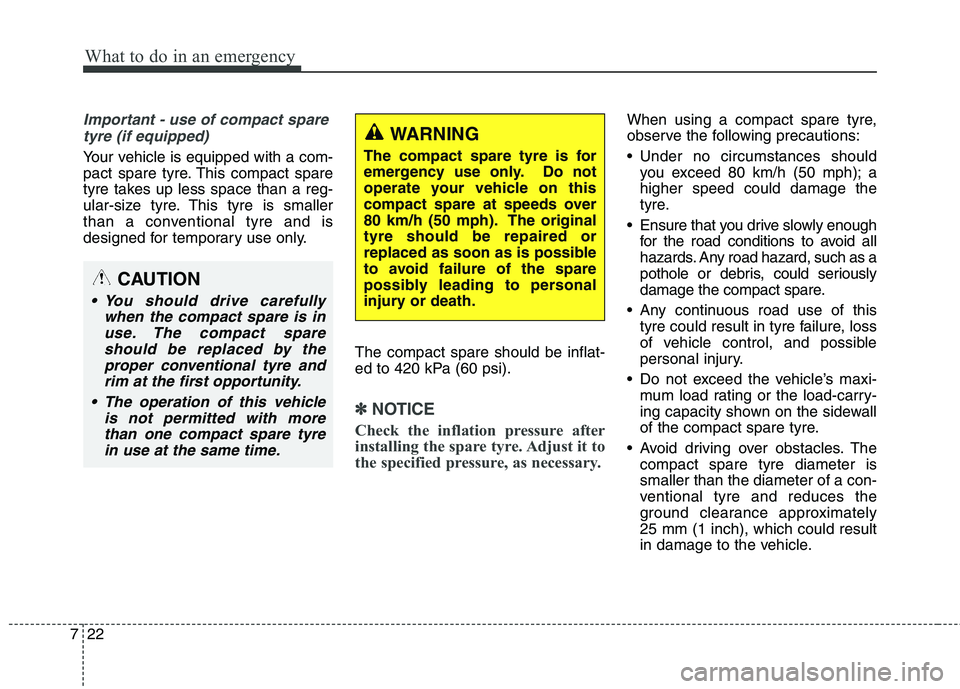
What to do in an emergency
22
7
Important - use of compact spare
tyre (if equipped)
Your vehicle is equipped with a com-
pact spare tyre. This compact spare
tyre takes up less space than a reg-
ular-size tyre. This tyre is smaller
than a conventional tyre and is
designed for temporary use only.
The compact spare should be inflat-
ed to 420 kPa (60 psi).
✽✽NOTICE
Check the inflation pressure after
installing the spare tyre. Adjust it to
the specified pressure, as necessary.
When using a compact spare tyre,
observe the following precautions:
Under no circumstances should you exceed 80 km/h (50 mph); a higher speed could damage the
tyre.
Ensure that you drive slowly enough for the road conditions to avoid all
hazards. Any road hazard, such as a
pothole or debris, could seriously
damage the compact spare.
Any continuous road use of this tyre could result in tyre failure, loss
of vehicle control, and possible
personal injury.
Do not exceed the vehicle’s maxi- mum load rating or the load-carry-
ing capacity shown on the sidewall
of the compact spare tyre.
Avoid driving over obstacles. The compact spare tyre diameter issmaller than the diameter of a con-
ventional tyre and reduces the
ground clearance approximately25 mm (1 inch), which could result
in damage to the vehicle.
CAUTION
You should drive carefully
when the compact spare is inuse. The compact spareshould be replaced by theproper conventional tyre and rim at the first opportunity.
The operation of this vehicle is not permitted with morethan one compact spare tyrein use at the same time.
WARNING
The compact spare tyre is for
emergency use only. Do not
operate your vehicle on this
compact spare at speeds over
80 km/h (50 mph). The originaltyre should be repaired or
replaced as soon as is possible
to avoid failure of the spare
possibly leading to personal
injury or death.
Page 573 of 723
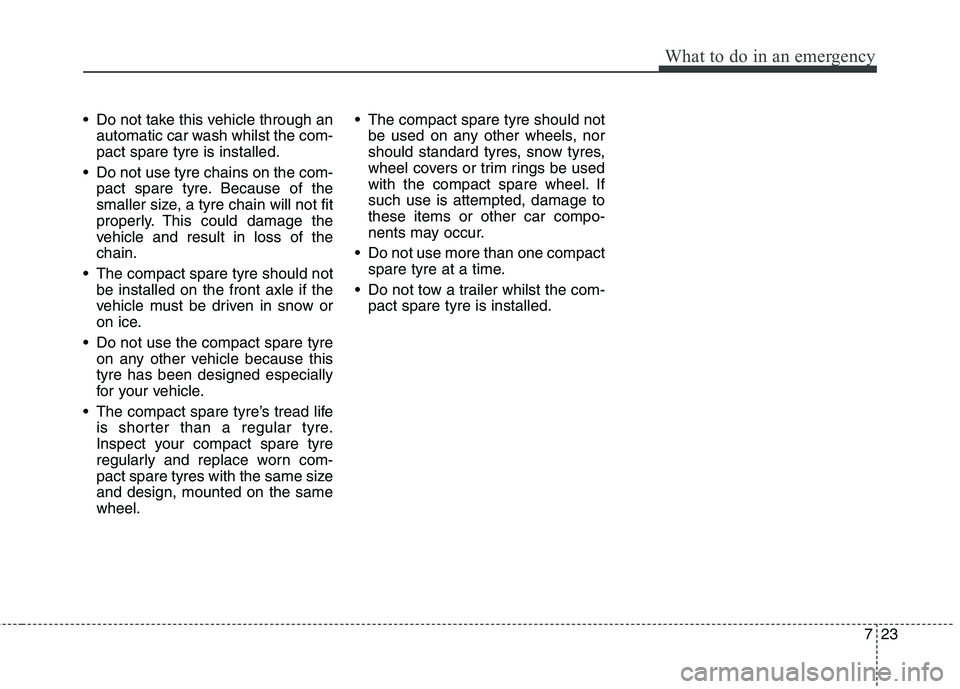
723
What to do in an emergency
Do not take this vehicle through anautomatic car wash whilst the com- pact spare tyre is installed.
Do not use tyre chains on the com- pact spare tyre. Because of the
smaller size, a tyre chain will not fit
properly. This could damage the
vehicle and result in loss of thechain.
The compact spare tyre should not be installed on the front axle if the
vehicle must be driven in snow or
on ice.
Do not use the compact spare tyre on any other vehicle because thistyre has been designed especially
for your vehicle.
The compact spare tyre’s tread life is shorter than a regular tyre.
Inspect your compact spare tyre
regularly and replace worn com-
pact spare tyres with the same sizeand design, mounted on the samewheel. The compact spare tyre should not
be used on any other wheels, nor
should standard tyres, snow tyres,
wheel covers or trim rings be used
with the compact spare wheel. Ifsuch use is attempted, damage tothese items or other car compo-
nents may occur.
Do not use more than one compact spare tyre at a time.
Do not tow a trailer whilst the com- pact spare tyre is installed.
Page 574 of 723
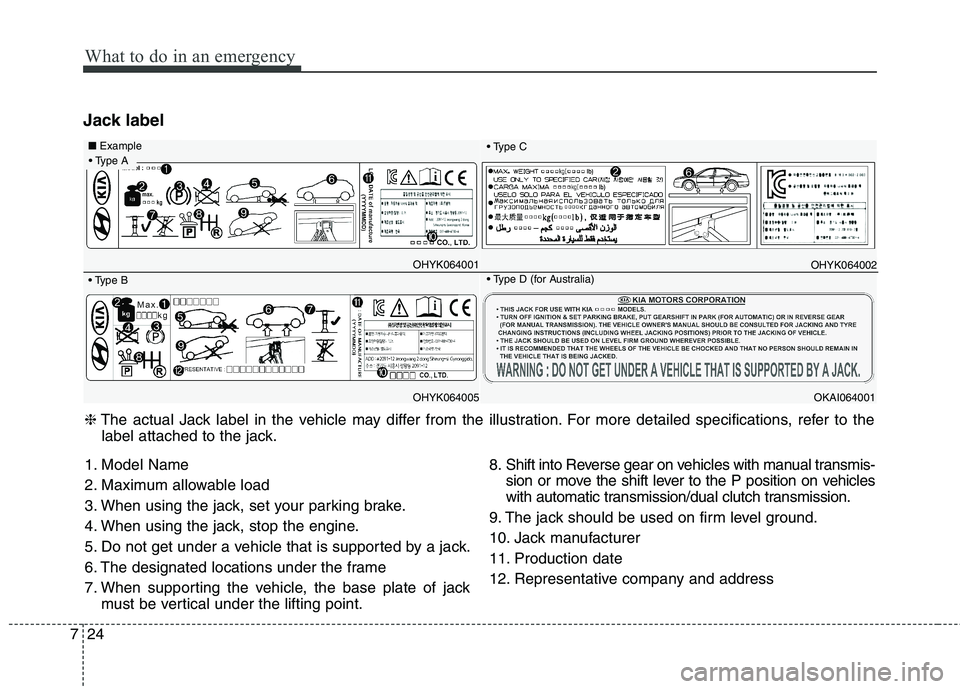
What to do in an emergency
24
7
Jack label
❈ The actual Jack label in the vehicle may differ from the illustration. For more detailed specifications, refer to the
label attached to the jack.
OHYK064002
■ Example
OHYK064005
OHYK064001
OKAI064001
1. Model Name
2. Maximum allowable load
3. When using the jack, set your parking brake.
4. When using the jack, stop the engine.
5. Do not get under a vehicle that is supported by a jack.
6. The designated locations under the frame
7. When supporting the vehicle, the base plate of jack must be vertical under the lifting point. 8. Shift into Reverse gear on vehicles with manual transmis-
sion or move the shift lever to the P position on vehicles
with automatic transmission/dual clutch transmission.
9. The jack should be used on firm level ground.
10. Jack manufacturer
11. Production date
12. Representative company and address
Page 575 of 723
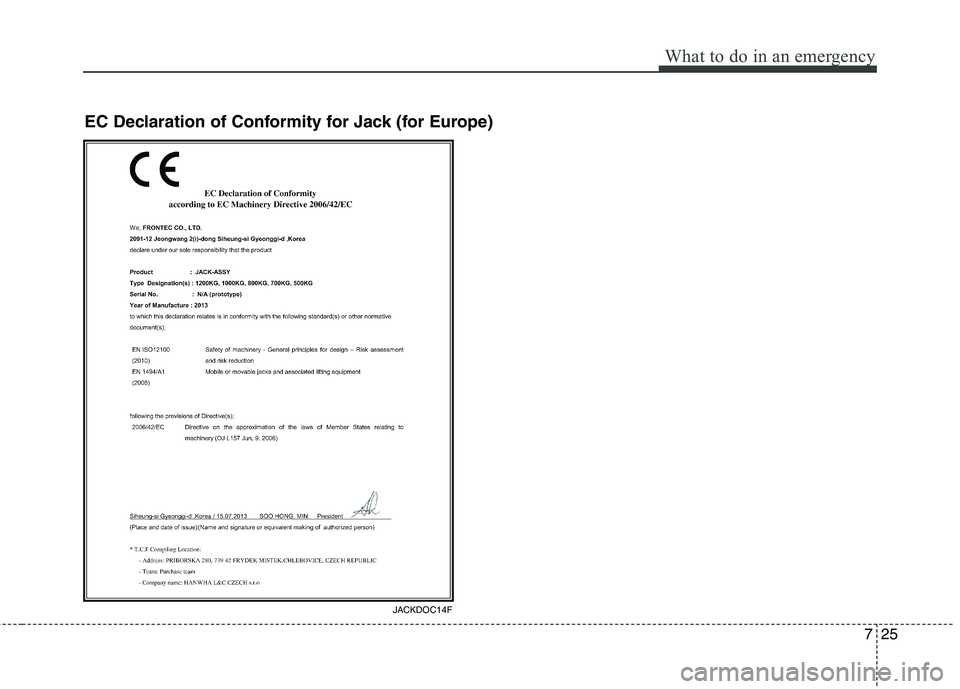
725
What to do in an emergency
EC Declaration of Conformity for Jack (for Europe)
JACKDOC14F
Page 576 of 723
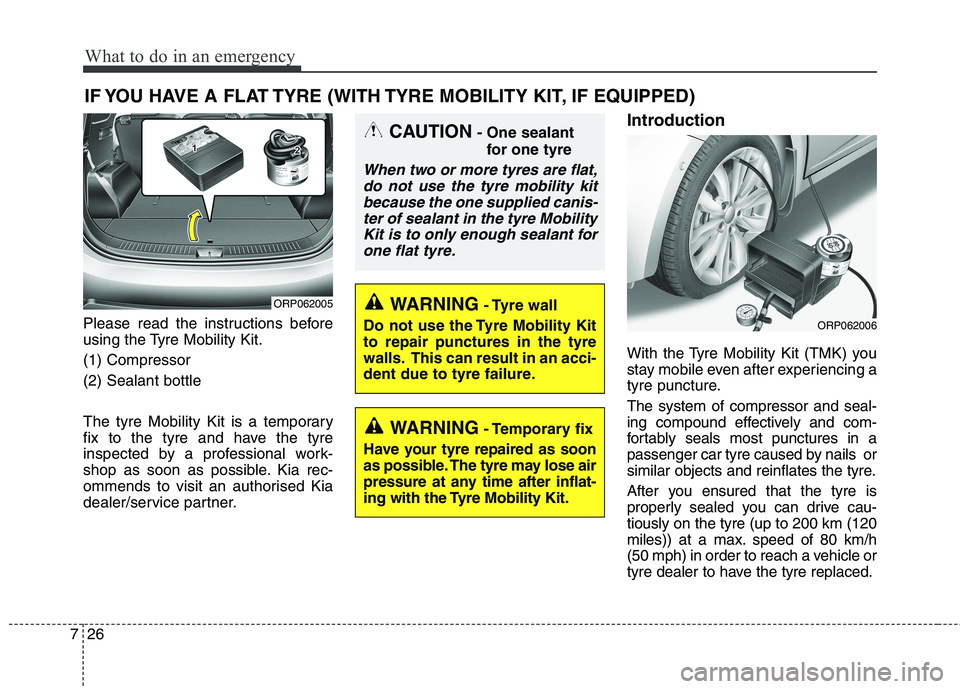
What to do in an emergency
26
7
IF YOU HAVE A FLAT TYRE (WITH TYRE MOBILITY KIT, IF EQUIPPED)
Please read the instructions before
using the Tyre Mobility Kit. (1) Compressor(2) Sealant bottle
The tyre Mobility Kit is a temporary
fix to the tyre and have the tyre
inspected by a professional work-
shop as soon as possible. Kia rec-
ommends to visit an authorised Kia
dealer/service partner. Introduction
With the Tyre Mobility Kit (TMK) you
stay mobile even after experiencing a
tyre puncture. The system of compressor and seal-
ing compound effectively and com-
fortably seals most punctures in a
passenger car tyre caused by nails or
similar objects and reinflates the tyre.
After you ensured that the tyre is
properly sealed you can drive cau-tiously on the tyre (up to 200 km (120
miles)) at a max. speed of 80 km/h
(50 mph) in order to reach a vehicle or
tyre dealer to have the tyre replaced.
ORP062006
ORP062005
CAUTION
- One sealant
for one tyre
When two or more tyres are flat,do not use the tyre mobility kitbecause the one supplied canis- ter of sealant in the tyre MobilityKit is to only enough sealant forone flat tyre.
WARNING - Tyre wall
Do not use the Tyre Mobility Kit to repair punctures in the tyre
walls. This can result in an acci-
dent due to tyre failure.
WARNING - Temporary fix
Have your tyre repaired as soon
as possible. The tyre may lose air
pressure at any time after inflat-
ing with the Tyre Mobility Kit.
Page 577 of 723
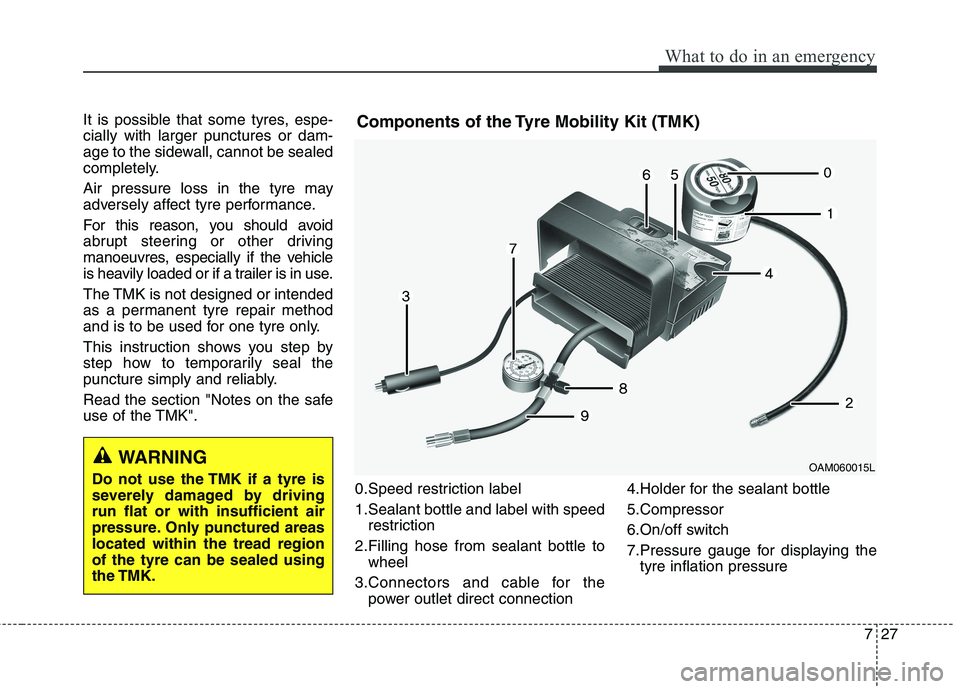
727
What to do in an emergency
It is possible that some tyres, espe- cially with larger punctures or dam-
age to the sidewall, cannot be sealed
completely.
Air pressure loss in the tyre may
adversely affect tyre performance.
For this reason, you should avoid
abrupt steering or other driving
manoeuvres, especially if the vehicle
is heavily loaded or if a trailer is in use.
The TMK is not designed or intended
as a permanent tyre repair method
and is to be used for one tyre only.
This instruction shows you step by
step how to temporarily seal the
puncture simply and reliably.
Read the section "Notes on the safe
use of the TMK".0.Speed restriction label
1.Sealant bottle and label with speedrestriction
2.Filling hose from sealant bottle to wheel
3.Connectors and cable for the power outlet direct connection 4.Holder for the sealant bottle
5.Compressor
6.On/off switch
7.Pressure gauge for displaying the
tyre inflation pressure
OAM060015LWARNING
Do not use the TMK if a tyre is
severely damaged by drivingrun flat or with insufficient air
pressure. Only punctured areaslocated within the tread regionof the tyre can be sealed usingthe TMK.
Components of the Tyre Mobility Kit (TMK)
Page 578 of 723
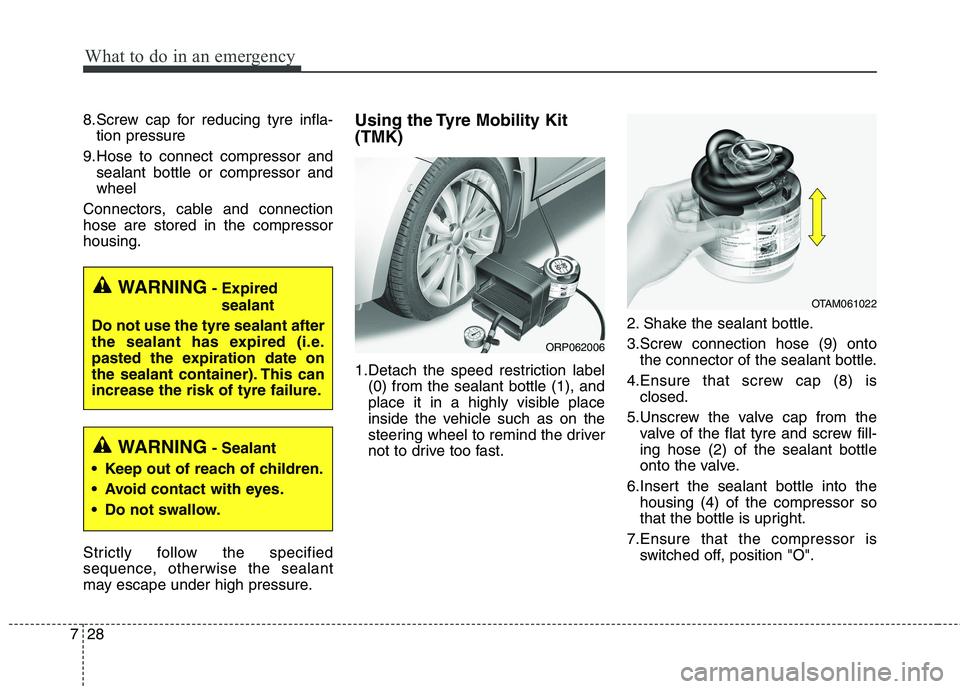
What to do in an emergency
28
7
8.Screw cap for reducing tyre infla-
tion pressure
9.Hose to connect compressor and sealant bottle or compressor and wheel
Connectors, cable and connectionhose are stored in the compressorhousing.
Strictly follow the specified
sequence, otherwise the sealant
may escape under high pressure. Using the Tyre Mobility Kit (TMK)
1.Detach the speed restriction label
(0) from the sealant bottle (1), and
place it in a highly visible place
inside the vehicle such as on the
steering wheel to remind the driver
not to drive too fast. 2. Shake the sealant bottle.
3.Screw connection hose (9) onto
the connector of the sealant bottle.
4.Ensure that screw cap (8) is closed.
5.Unscrew the valve cap from the valve of the flat tyre and screw fill- ing hose (2) of the sealant bottle
onto the valve.
6.Insert the sealant bottle into the housing (4) of the compressor so
that the bottle is upright.
7.Ensure that the compressor is switched off, position "O".
WARNING - Expired
sealant
Do not use the tyre sealant after
the sealant has expired (i.e.
pasted the expiration date on
the sealant container). This can
increase the risk of tyre failure.
WARNING - Sealant
Keep out of reach of children.
Avoid contact with eyes.
Do not swallow.
ORP062006
OTAM061022
Page 579 of 723
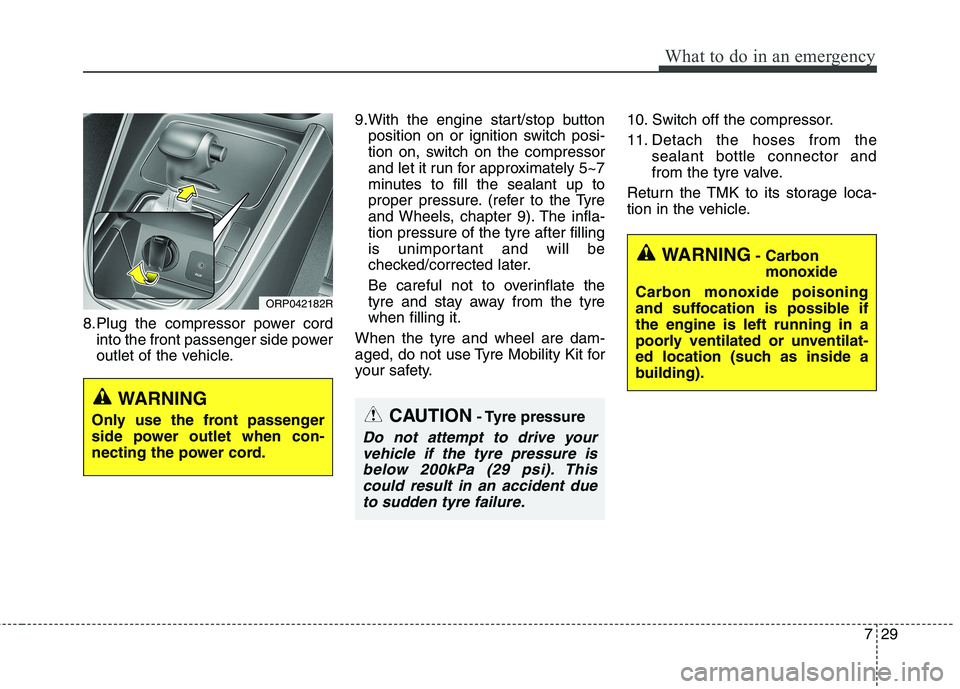
729
What to do in an emergency
8.Plug the compressor power cordinto the front passenger side power
outlet of the vehicle. 9.With the engine start/stop button
position on or ignition switch posi-
tion on, switch on the compressor
and let it run for approximately 5~7
minutes to fill the sealant up to
proper pressure. (refer to the Tyre
and Wheels, chapter 9). The infla-tion pressure of the tyre after filling
is unimportant and will be
checked/corrected later.
Be careful not to overinflate the
tyre and stay away from the tyrewhen filling it.
When the tyre and wheel are dam-
aged, do not use Tyre Mobility Kit for
your safety. 10. Switch off the compressor.
11. Detach the hoses from the
sealant bottle connector and
from the tyre valve.
Return the TMK to its storage loca-
tion in the vehicle.
WARNING - Carbon
monoxide
Carbon monoxide poisoning
and suffocation is possible ifthe engine is left running in a
poorly ventilated or unventilat-
ed location (such as inside a
building).
WARNING
Only use the front passenger
side power outlet when con-
necting the power cord.
CAUTION - Tyre pressure
Do not attempt to drive your
vehicle if the tyre pressure is below 200kPa (29 psi). Thiscould result in an accident dueto sudden tyre failure.
ORP042182R
Page 580 of 723
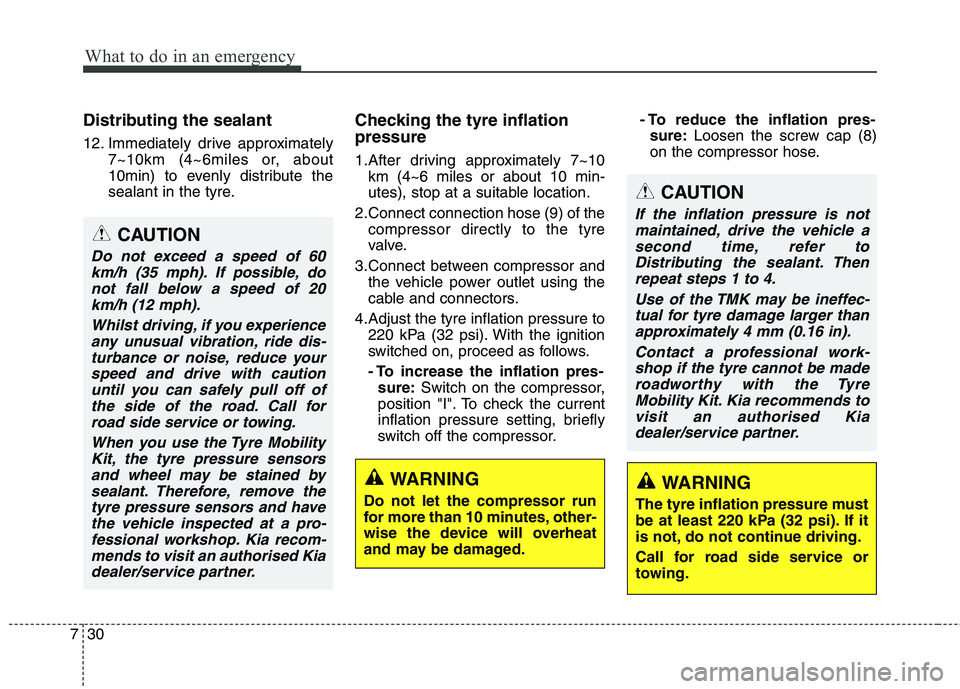
What to do in an emergency
30
7
Distributing the sealant
12. Immediately drive approximately
7~10km (4~6miles or, about
10min) to evenly distribute the
sealant in the tyre. Checking the tyre inflation pressure
1.After driving approximately 7~10
km (4~6 miles or about 10 min-
utes), stop at a suitable location.
2.Connect connection hose (9) of the compressor directly to the tyre
valve.
3.Connect between compressor and the vehicle power outlet using the
cable and connectors.
4.Adjust the tyre inflation pressure to 220 kPa (32 psi). With the ignition
switched on, proceed as follows.
- To increase the inflation pres-sure: Switch on the compressor,
position "I". To check the current
inflation pressure setting, briefly
switch off the compressor. - To reduce the inflation pres-
sure: Loosen the screw cap (8)
on the compressor hose.
CAUTION
Do not exceed a speed of 60
km/h (35 mph). If possible, donot fall below a speed of 20 km/h (12 mph).
Whilst driving, if you experienceany unusual vibration, ride dis-turbance or noise, reduce yourspeed and drive with caution until you can safely pull off ofthe side of the road. Call forroad side service or towing.
When you use the Tyre MobilityKit, the tyre pressure sensors and wheel may be stained bysealant. Therefore, remove thetyre pressure sensors and have the vehicle inspected at a pro-fessional workshop. Kia recom-mends to visit an authorised Kiadealer/service partner.
WARNING
Do not let the compressor run
for more than 10 minutes, other-
wise the device will overheat
and may be damaged.
CAUTION
If the inflation pressure is not maintained, drive the vehicle asecond time, refer toDistributing the sealant. Then repeat steps 1 to 4.
Use of the TMK may be ineffec-tual for tyre damage larger thanapproximately 4 mm (0.16 in).
Contact a professional work-shop if the tyre cannot be made roadworthy with the TyreMobility Kit. Kia recommends tovisit an authorised Kia dealer/service partner.
WARNING
The tyre inflation pressure must
be at least 220 kPa (32 psi). If it
is not, do not continue driving.
Call for road side service or
towing.